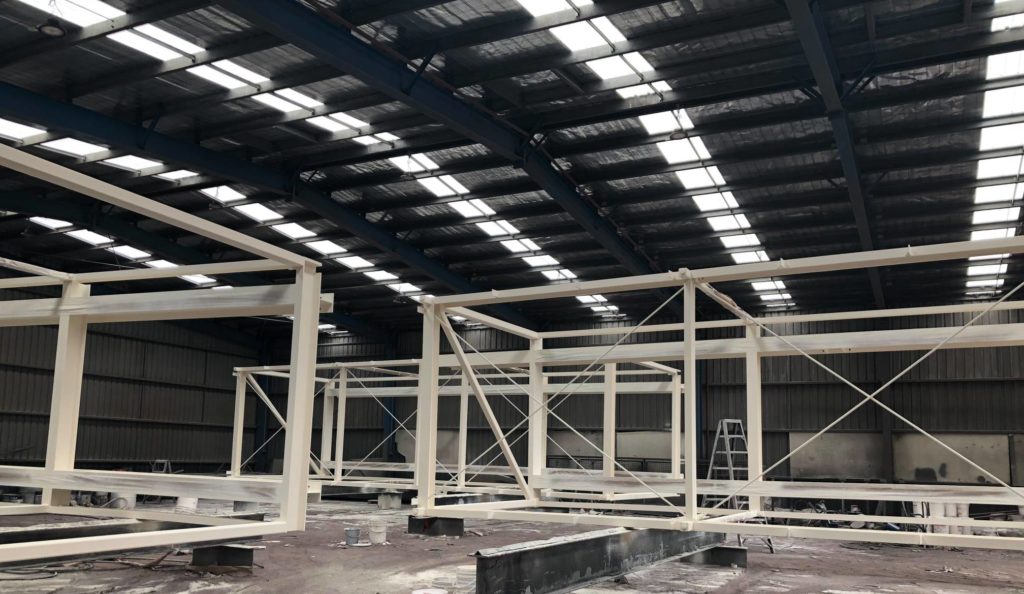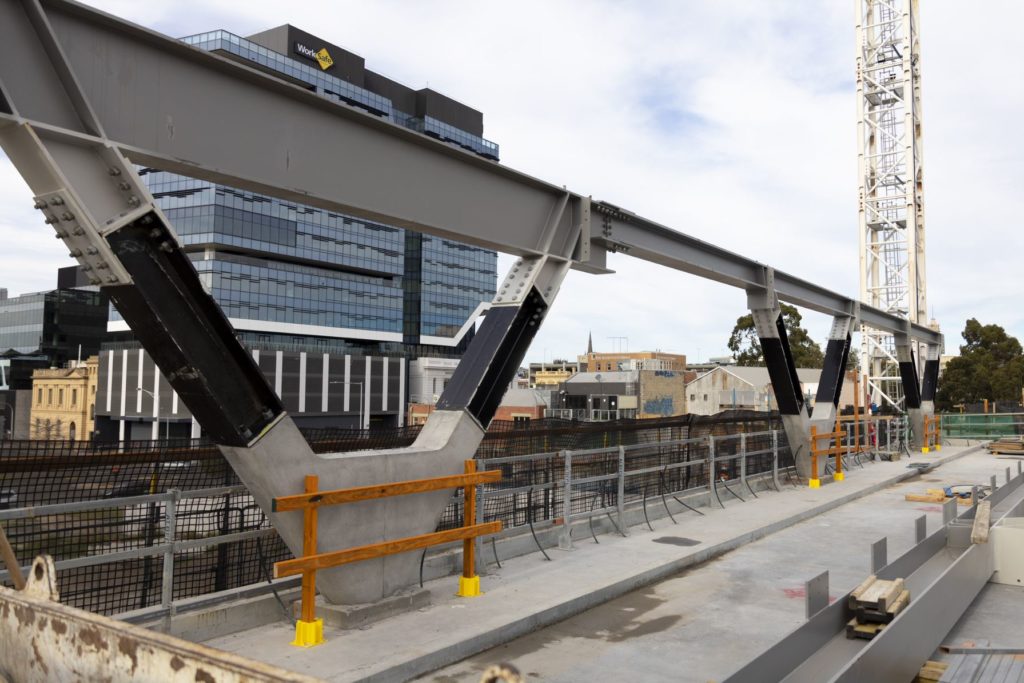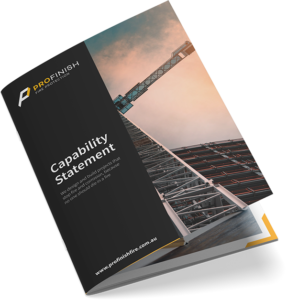There are many benefits to both on and off-site passive fireproofing, especially when it comes to thin-film intumescents, known for their high standards of finish, quality, reliability, and varying options for fire resistance. From potentially less transportation risks by fireproofing on-site, to being able to fully control the environment and lowering dry-time by installing off-site, the correct approach will come down to several key factors. In this article, we’ll look at the pros and cons of each approach, to assist you in making an informed decision on your next project.
Offsite Application
Fireproofing off-site has a wide range of benefits. Off-site intumescent applications are rising in popularity as contractors and project managers are beginning to see for themselves how beneficial this method can be, as well as how easily it can be scheduled into a construction project plan.
Streamlining construction
Structural steel is sent directly from the steel fabricator to the fireproofing supplier’s factory for the intumescent coatings to be applied. This means that by the time it arrives on-site, it is effectively fireproofed and ready for installation.
Expert damage control
To ensure that there is no damage made to the steel during transport from the factory to the site, slings are used instead of chains when moving the steel, which reduces the risk of damage. If damage does occur, the fire protection team is able to touch up the areas onsite with no lengthy setup or messy cleanup required. They simply fill any indentation and apply a topcoat with a brush.

Full control
The application of intumescent coatings is completed in a double-walled factory. This allows the team to fully control the environment and avoid any weather or site issues. The off-site approach also ensures the best quality application of the fireproofing material, with no risk of inter-coat contamination – known to impact the quality of the coatings. In addition, overspray is mitigated because the intumescent is applied in a controlled space, which also means that the drying time is accelerated. Because installing off-site mitigates the potential of application delays due to weather and other factors, the prepared steel can be delivered to the project’s site on time, meaning construction can continue as scheduled.
Reducing Project Costs
While contractors and Project Managers might find intumescent seems more expensive on paper, they may not be considering the fact that fire protection quotes take into account the application of the product, not the costs that are accrued on-site. These include costs for delaying trades due to access requirements, masking up, fume extraction, weather disruptions, and clean-up times.
One also needs to consider the fact that offsite application means fewer people and materials on-site, which results in overall construction efficiency.
Advantages of off-site application:
- Streamlines project management and improves process efficiency
- Allows unmatched quality control
- Mitigates any disruption to the site
- Mitigates the risk of overspray to the site
- Reduces the OHS risks due to VOCs
- Reduces the potential for delays
- Reduced waste, which improves the site’s Green Star Efficiency rating
Disadvantages of off-site application:
- Possibility of damage during transport
- If damage occurs, an applicator needs access to the site to touch up
- The potential for higher transport costs
To ensure that our clients get the most accurate idea of fireproofing costs, PROFINISH includes all transportation costs in our quotes.
Onsite Application
Many architects and Project Managers default to the on-site application of intumescent coatings. However, there are many other options they may be failing to consider. Additionally, the onsite application of intumescents is not always straightforward. This is true for a number of reasons:
Weather Dependency
The application of intumescent requires a completely dry environment. Ideal conditions include an ambient air temperature of 10-35 degrees and humidity levels lower than 80%. Since intumescent requires such precise conditions, the forecast of rain, cold weather or dew during scheduled fireproofing application can significantly delay a project. In the wetter Autumn and Winter seasons, an application can be delayed for up to several weeks, seriously impacting a project’s timeline
Preparation, Layers and Drying Times
Depending on the fire-resistant level (FRL) required, onsite application of intumescent paint can typically take between 4 to 7 days, depending on the size of the job. This estimate takes many factors into consideration, including:
- The time to mask up and encapsulate the local environment
- Applying the required thickness of paint
- Allow for drying time in between layers
- Site cleanup
On-site application of intumescent paint consists of one or multiple layers of primer, multiple layers of base coat, and a topcoat. The number of layers required depends on the desired FRL indicated for the steel member. For many of the products on the market, it is best practice to apply up to a maximum of 1500 microns per day, each with a 24-hour drying period required for each layer. This means that drying time is a serious factor to consider in on-site project management.
Impact on Construction
Before the intumescent application can begin, the on-site area needs to be adequately prepared. This process involves masking up to protect the surroundings from any overspray, meaning that it would need to be vacated by other trades before commencing.
Once the area has been prepared, there are additional factors to consider. This means that other trades working nearby would need to stop or limit their work during the intumescent application. More importantly, Occupational Health and Safety requires other trades to vacate the site during the application of intumescent because of the presence of volatile organic compounds (VOCs) in intumescent paints. This results in all labour coming to a standstill, which could have a significantly negative impact on the project timeline, should other trades still be completing their tasks.

Advantages of on-site application:
- No transport or handling damage
- No additional transport costs after fabrication
Disadvantages of on-site application:
- High risk of uncontrollable delays due to weather
- High risk of disruption to other site works
- Potential inter-contamination due to site dust, etc…
- Slower overall construction, considering there is a minimum of one week for intumescent application
- High risk of disruption because of OHS compliance
- Potential for overspray damage or timely encapsulation required
Which approach is better?
As we’ve covered, there are pros and cons to both approaches. To find out which approach is better suited to your project, ask yourself:
What is the time pressure?
An onsite fireproofing application can take up to two weeks and needs at least seven days of clear and dry weather. An off-site application can happen immediately.
What month is it?
If your project falls within April through September, the chance of wet weather could significantly increase the risk of application delays. Off-site intumescent application is recommended.
Is the steel already installed?
If the steel has already been installed, your only choice is to opt for on-site installation.
What is the required Fire Resistance Level?
The FRL, Critical Temperatures, Type of intumescent coating and the Hp/A of the steel will determine how many microns need to be applied to the steel and therefore impact the duration of the onsite application.
Where is it being installed?
The higher a building level is, the more the weather will impact it during construction. In this case, with increased wind and potentially more contaminants, the quality control of the on-site installation will be significantly lower. Installing a fireproofing system off-site will allow you to control the environment and speed up project timelines.
Experts at on and off-site installations
There are many factors to consider when making the choice between on or off-site fireproofing installation. The final decision is always based on many factors surrounding the project, but where issues such as schedules, site access, Occupational Health & Safety and weather dependency are important, the off-site application is the recommended approach.
As experts in the passive fireproofing industry, PROFINISH can assist you with making the best decision around how to approach installation, offer you competitive quotes and have the experience needed to install fireproofing systems both on and off-site effectively. Get in touch with a member of the PROFINISH team today.

